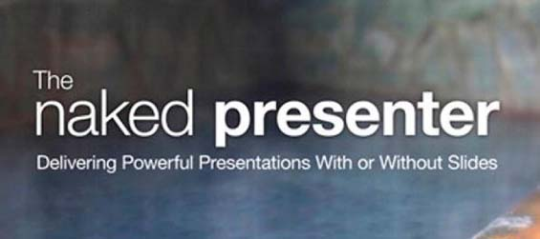
June 30th, 2012 by alephnaught
The Naked Presenter: Delivering Powerful Presentations With or Without Slides (Voices That Matter) (review)
- Title: The Naked Presenter: Delivering Powerful Presentations With or Without Slides (Voices That Matter)
- Author: Garr Reynolds
- Paperback: 216 pages
- Publisher: New Riders Press; 1 edition (December 9, 2010)
- Language: English
- ISBN-10: 0321704452
- ISBN-13: 978-0321704450
This could be an excellent book for a novice presenter. I really enjoyed reading this book, not only is it written well and paced nicely, I also learned a great deal. Follow are some of my notes and quotes I’ve pulled from the book.
The idea of a naked presentation is that the presenter is most important; “Most communication experts today agree that a good talk or a good presentation should feel more like a conversation.” This means your slides, or deck, is not critical and should not take center stage.
“Presentation is a creative activity and creativity requires you to take some time away from the myriad distractions in your life.” Set aside time to create your presentation, consider the audience, spend quiet time considering where the audience is starting from and where you want them to end up. “Design your content in a way that addresses the “why” from the audience’s point of view.” “You can go deep or you can go wide but it’s very difficult to do both in a single presentation.”
“Contrast is about differences—and we are hard wired to notice differences.”
- “Identify the problem. For example, this could be a problem that your product solves.
- “Identify causes of the problem. Give actual examples of the conflict surrounding the problem.
- “Show how and why you solved the problem. This is where you provide resolution to the conflict”
Steps to building a good presentation:
- “Create an oasis of solitude
- “Remove the distractions.
- “Go analog.
- “Identify your core point.
- “Brainstorm.
- “Consolidate, edit, and group your ideas.
- “Sketch your visuals.
- “Build visuals in software.”
“Conveniently, at least five proven ways to begin a talk from the acronym PUNCH: Personal, Unexpected, Novel, Challenging, or Humorous.”
“I recommend that you not start with an agenda slide. But, after you have made an initial connection with the audience, it’s a good idea to give people an idea where you are going in the time you have with them. You can usually do this verbally, in just a few seconds. If you have a lot of material, however, you may want to show the audience how your talk is structured and then remind them along the way where you are in the presentation.”
“You can even build black slides into a presentation to completely shift attention away from the screen. Pressing the B key is very useful, for example, if a spontaneous but relevant discussion diverges a bit from the visual information on the screen.” I’ve done this and it works.
There are 6 elements to a sticky message: “Simplicity, Unexpectedness, Concreteness, Credibility, Emotions, and Stories.”
Pacing is important – “Give your audience time to process.” Mix long sentences with short ones to create rhythm and to provide punch.
Suggestions for the room and audience:
- “shorten the distance between yourself and the audience,
- “bring individual audience members closer to each other while still being sensitive to local perceptions of personal space, and
- “remove any barriers between you and the audience that create distance, whether that distance is physical or merely a perception of the audience.”
Mr. Reynolds has spent a lot of time in Japan and uses Japanese analogies often: “In Japanese, the word passion—jounetsu ()—is composed of two Kanji (Chinese) characters, feeling () and heat ().”
I thought this hint was really good: “Although most people do not need notes for a presentation given with multimedia—constantly referring to notes would be a barrier and a distraction—it is a good idea to prepare a one-page list of key points in the unlikely event that your technology dies.”
And a nice tip for training: “Medina recommends beginning each module or 10-minute segment by explaining a core concept in general terms to give people the big picture, then spending the majority of the 10-minute segment providing details that support the core idea. After about 10 minutes, however, you have to do something to change things up to keep people engaged. For this, Medina suggests you introduce an emotionally competent stimulus (ECS) that gives the brain a break and serves as a hook that connects one module to another. These hooks must be relevant to the material and, of course, they must be emotional. It could be a story, a video clip, a case study, an image projected on-screen, or even a relevant amusing anecdote—anything that is relevant and triggers an emotion such as happiness, sadness, fear, nostalgia, incredulity, or any other human emotions.”
I’d like to wrap up this review with a quote from Aristotle that’s in this book: “When the storytelling goes bad in society, the result is decadence.” Go tell meaningful stories!
Revisions:
There are no revisions for this post.







3:59 pm on July 3rd, 2012
Presenting this way is an artform. Whenever I present this way it requires the material be vey near & dear to my heart, without a ton of need for data to support my presentation. I love this style from both an audience member & presenter. Key – really great material!
Translate